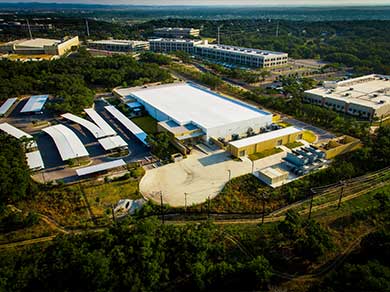
For the most part, what we do on our cell phones, tablets, and other devices use data that isn’t actually on them.
The TV shows we stream, social media we scroll through, and documents we review pull data that reside somewhere…but typically not on our devices.
Enter the data center, where the data is actually housed. Data centers may appear like large, windowless warehouses, but their nondescript looks hide the array of video meetings, financial transactions, artificial intelligence computations, and cat memes that purr inside their servers. The data center demand today already threatens to outpace supply, and as data-enabled tech continues to extend its reach into everyday life, the need for data centers will continue to grow.
The flourishing of the ethereal, in-the-cloud dataverse is creating a bloom of concrete, on-the-ground buildings to house that data. Texas has seen clumps of data centers pop up in Dallas-Fort Worth, Austin, and San Antonio. Why Central and North Texas? “The desirable—and relatively rare—combination of available land, reliable power, diverse fiber optic cables, and general insulation from major natural disasters like hurricanes and tornadoes,” replies Tom Carter, P.E., Senior Vice President at Pape-Dawson Engineers, LLC.
Although they may look like big boxes, Pape-Dawson’s extensive experience with data centers has shown that they are much more complex than meets the eye. “From a civil design perspective, it’s straight forward,” says Engineer IV Tyler Kozma, EIT. “But from the perspective of due diligence and coordination, there’s so much more involved. This isn’t just another industrial building.” Tyler’s experience working on a recent data center project involved a complex, lengthy process with up to a dozen calls a week. “On those calls, there were subject-matter experts for everything you could think of: power, water, wastewater, security, and so on,” he says.
The difficult synchronization of what a data center needs to function makes planning complicated. Abundant power tops the list, says Tom. “The first consideration is power availability, informed by our conversations with power providers.” Alex Childers, Senior Director, Finance, says, “We’ve found it can be a challenge to try to orchestrate those elements. No one wants to start construction of a building without a guarantee there’ll be electricity to power it. But electric companies can be reluctant to commit to erecting transmission lines and substations needed by a data center that doesn’t exist yet.”
Power is hardly the only need, though. Servers produce a significant amount of heat and require constant cooling to stay functional. Water is the most common cooling agent, says Alex. “Evaporative-cooled data centers are very water-intensive, which is a big problem in some places. Air cooling, which is becoming more popular, cuts 98% of the water use, so you alleviate the water concern, but it increases electricity requirements.” Data centers need access to fiber optic cables, too, with multiple fiber providers running major lines nearby for the data center to tie in to.
Backups keep things running, even if one system falters. “Every system in a data center—including power, fiber, cooling water, and everything else—has significant redundancy,” explains Tom. For instance, a data center may have power coming from a dedicated substation, with looped transmission lines to ensure continued operations if one line fails. In a disruption of mainline power, a battery bank called an uninterruptible power supply (UPS) provides electricity for a few minutes until onsite generators ramp up to capacity.
Although data centers draw on local resources like power, they don’t add much traffic or require the additional roadway infrastructure of a typical industrial facility because only a dozen or so employees work there each shift. Further, the financial boost for a local government can be considerable, adds Alex, “It’s an easy sell once you work through electrical, water, and sound considerations. It’s a very expensive building, so it can be a significant provider of long-term property tax revenue.”
Technology changes quickly. For that reason, data centers do, too. The giants of cloud storage and computing, known in the industry as hyperscalers, have been building and leasing data centers since the widespread use of cloud services. To meet today’s pressing demand, data center developers and operators (who build data centers expressly to lease to other companies) have increased their activity to meet the insatiable demand.
Change will remain a major theme in data center planning and construction. “The needs and design standards are always changing,” says Tom. “We thought the data centers we built 10 or 15 years ago were giant projects, but they’re nothing compared to today’s.” As computing advances cascade into businesses and consumers’ lives, the data centers they rely on will change and proliferate to meet their needs. Pape-Dawson’s consistent experience in the industry allows us to be a valuable partner to hyperscalers, developers, architects, and others in the data center space.
Download the article here: Adventures in the Dataverse (or What That New Building Just Outside Town Has to Do with Your Phone)